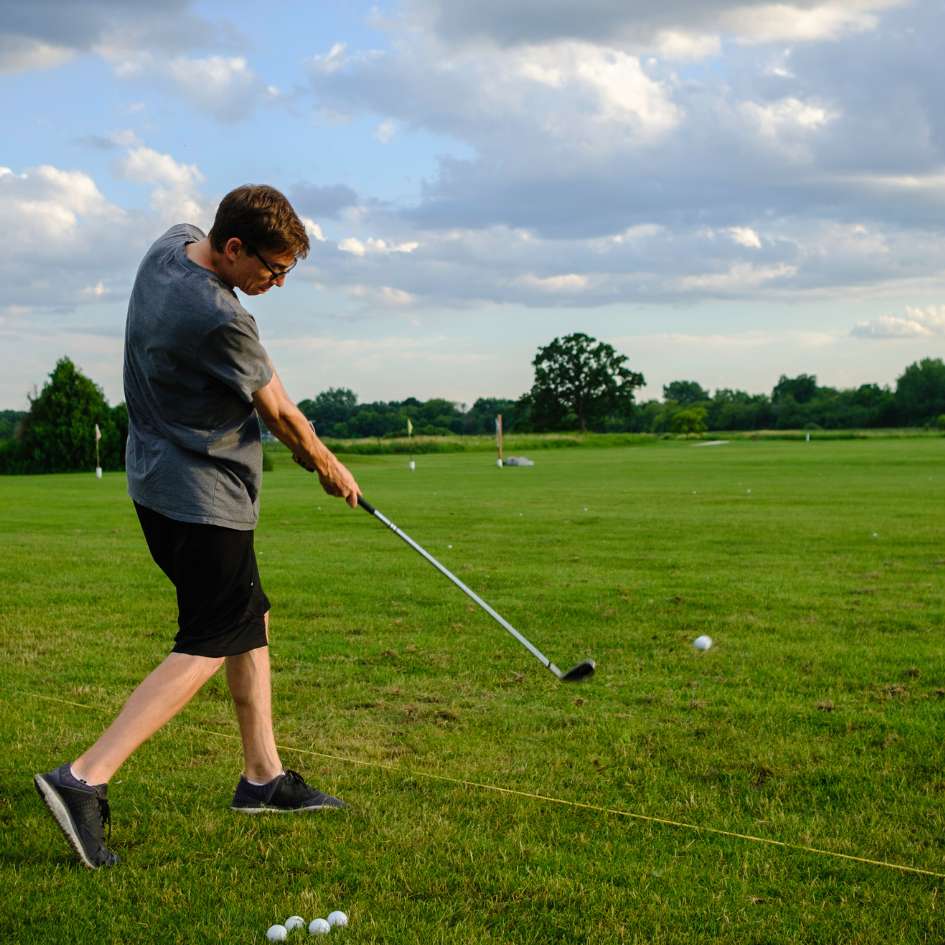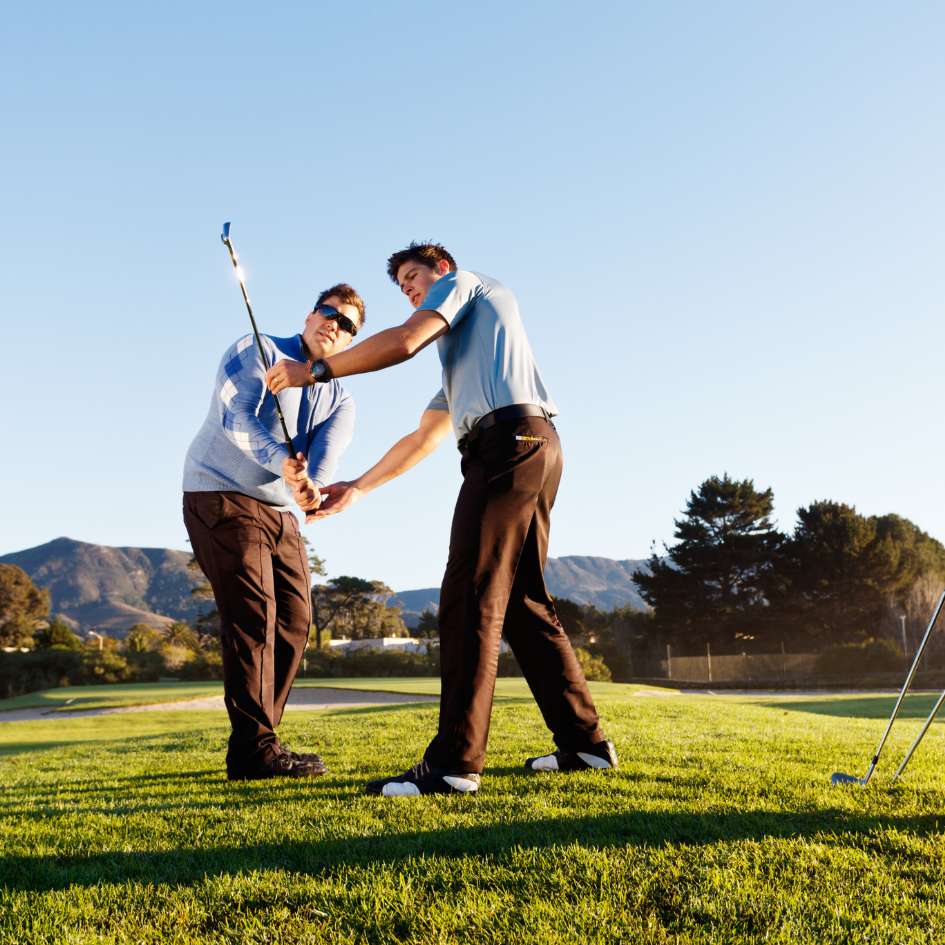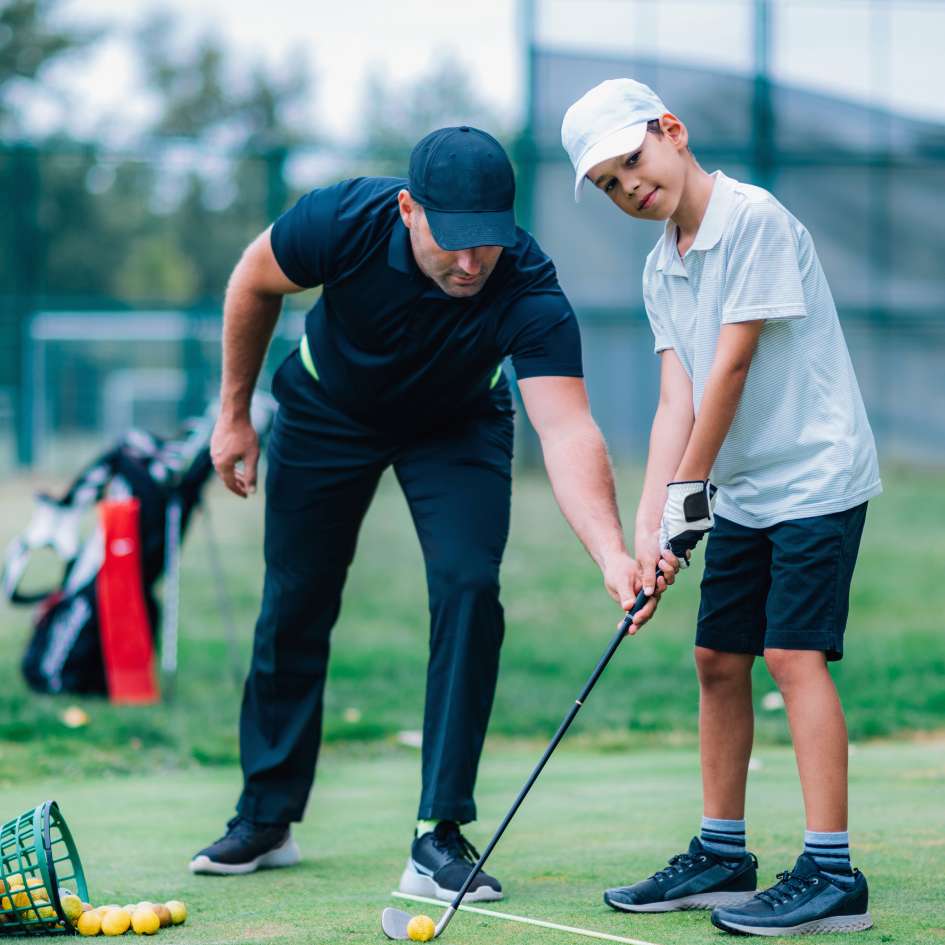
How to Hit a Golf Chip Shot for Beginners
How to Hit a Golf Chip Shot for Beginners
Perfecting the Basics: A Beginner's Guide to Mastering Chip Shots in Golf
Welcome to Golf For Beginners Academy, where we simplify the art of golf for novice players. Today, we’re unveiling a beginner-friendly guide on executing chop shots with precision. These fundamental tips will enhance your control and bring you one step closer to achieving those dreamy shots around the green.
Unlocking Success: Beginner-Friendly Tips for Chip Shots
Perfecting your chip shot is crucial for close-to-the-hole success. Let’s dive into these beginner-friendly tips to make your contact with the ball better than ever.
Build the Right Foundation: Start with a setup tailored to your shot. Place the ball under your sternum, hands just inside the left thigh, and weight distributed 55% on the left foot and 45% on the right. This ensures proper shaft lean for smooth club motion.
Which Way Are You Swinging? Swing the club along the established plane. Coordinate wrist movements and body rotation to match the swing plane for a seamless backswing.
An Open Face is a Happy Face: Allow the clubface to open during the backswing. An open clubface promotes a gliding motion over the ground, ensuring a smoother impact and release.
Let It Go, Let It Go!: In the downswing, permit your hands and wrists to move freely. Avoid forcing the club; let it follow its natural flow for a more controlled impact.
Your Release Needs Backup: Support the wrist release with a rotation of the upper body. A coordinated motion of the upper and lower body in the follow-through ensures a balanced and controlled release.
Up Up Up: Move certain parts of your body upward during the motion, especially the grip of the club. Ensure your head, body, and shoulders extend slightly, allowing the clubhead to move downward while the grip moves upward.
You’ve Got to Go Forward!: In the finish position, shift about 90% of your weight onto the front foot. This improves control over the club’s contact point and ensures a stable finish.
How Far Are You Going?: Maintain consistent swing lengths in both backswing and follow-through. An equal-length backswing and follow-through enhance low point control and distance accuracy.
Please Don’t Kill the Bird!: Grip the club with the right pressure. Experiment with different grip pressures (1 to 10 scale) to find the one that allows a natural release and consistent impact conditions.
Yes - Lets go!
Congratulations! You’ve just unlocked the secrets to mastering chip shots in golf. Practice these beginner-friendly tips consistently, and you’ll soon find yourself confidently navigating the short game. Happy chipping!
Ready to Take the Plunge? ⛳️
You’ve learned about how to master the chip shot. If you’re eager to dive deeper into golf’s intriguing world and master the ins and outs of the game, look no further than our “Golf For Beginners – The Ultimate Starter Guide.” Whether you’re a newbie or just brushing up on your skills, this online course has something for everyone.
⛳️ Discover the Ultimate Golf Starter Guide Right Here ⛳️
Did you like How to Hit a Golf Chip Shot for Beginners?
If you want more detailed help with you game of golf, and specifically about the short game of golf, our partner-portal called World Of Short Game deliver great content for all short game related topics. Click here to visit World Of Short Game.
And if you live in Denmark, never hesitated to reach out to Danish Golf Academy for help with any part of your game.

Mastering the Basics: How to Grip a Golf Club Correctly for Beginners
How to Grip a Golf Club Correctly for Beginners
Mastering the Basics
Welcome to Golf For Beginners Academy, where we’re committed to helping aspiring golfers like you tee off on the right foot! Today, we’re diving into a fundamental aspect of the game that every beginner needs to get a grip on – literally. In this guide, we’ll explore the art of holding a golf club correctly, ensuring you set the stage for a solid swing and an enjoyable golfing journey.
Understanding the Importance of a Proper Grip
The foundation of a successful golf swing starts with the grip. A correct grip not only influences your control over the club but also impacts the trajectory, accuracy, and power of your shots. So, let’s get started on the path to a great golf grip.
Getting a Hold of It – Step by Step:
Understanding the Basics: Before diving into the nitty-gritty, let’s establish the basics. The grip consists of the hands – the lead hand (left hand for right-handed golfers) and the trail hand (right hand for right-handed golfers).
Positioning the Lead Hand: Begin by placing the club in the fingers of your lead hand, not the palm. The handle should run diagonally across the fingers, with the grip extending from the base of your pinkie to the middle joint of your index finger. This creates the foundation for control and precision.
Adding the Trail Hand: With the lead hand in position, bring in the trail hand. Overlap the fingers of the trail hand with the spaces between the fingers of the lead hand. Ensure that both hands work together in harmony, fostering unity and control throughout your swing.
Checking Knuckle Alignment: A quick check to ensure you’re on the right track – your lead hand’s knuckles should be visible, forming a “V” with the thumb and index finger. This helps in creating a square clubface at impact.
Balancing Grip Pressure: Find the sweet spot when it comes to grip pressure. Too tight, and you risk tension in your swing; too loose, and control becomes elusive. Aim for a firm yet relaxed grip – think of holding a small bird; tight enough not to let it escape, but gentle enough not to harm it.
Common Mistakes to Avoid:
- Death Grip: Avoid squeezing the life out of the club. A relaxed grip promotes fluidity in your swing.
- Faulty Finger Placement: Ensure the handle runs through the fingers, not cradled in the palms.
- Inconsistent Hand Positioning: Maintain a consistent grip from shot to shot for stability and control.
Conclusion
Congratulations! You’ve just taken the first step toward mastering your golf game by learning how to grip a golf club correctly. Practice this fundamental skill consistently, and you’ll soon find yourself making more confident and controlled swings on the course. Stay tuned to Golf For Beginners Academy for more valuable insights to enhance your golfing journey. Happy swinging!
Ready to Take the Next Step? 
You’ve learned about the grip, good job! If you’re eager to dive deeper into golf’s intriguing world and master the ins and outs of the game, look no further than our “Golf For Beginners – The Ultimate Starter Guide.” Whether you’re a newbie or just brushing up on your skills, this online course has something for everyone.
⛳️ Discover the Ultimate Golf Starter Guide Right Here ⛳️

How do I improve my golf swing? 25 Checkpoints
How do I improve my golf swing? 25 Checkpoints
Strategies on How to Improve Your Golf Swing
Welcome to Golf For Beginners Academy, where we unravel the mysteries of refining your golf swing. If you find yourself pondering the question, “How do I improve my golf swing?” – you’re in the right place. In this detailed guide, we’ll delve into a variety of strategies to enhance your swing and, consequently, elevate your overall golf performance.
Understanding the Mechanics: The Foundation of Improvement
To improve your golf swing, it’s essential to understand the foundational mechanics that contribute to a successful and consistent motion.
Grip Refinement: Start by evaluating and refining your grip. A proper grip establishes control and allows for a more natural release of the clubhead.
Posture Assessment: Analyze your posture during setup. Ensure a balanced and athletic stance, promoting better weight distribution and stability throughout the swing.
Alignment Precision: Check your alignment regularly. Misalignment can lead to inaccurate shots, so ensuring proper alignment is a fundamental step in refining your golf swing.
Mastering the Takeaway: Focus on a smooth and controlled takeaway. A well-executed takeaway sets the stage for the entire swing sequence.
Balancing Weight Transfer: Practice a seamless weight transfer during your swing. A balanced shift from backswing to downswing contributes to power and accuracy.

Addressing Common Swing Flaws
Identifying and addressing common swing flaws is crucial for continuous improvement.

Slice Correction: If you’re struggling with a slice, analyze your clubface angle and swing path. Adjustments to your grip and swing plane can help correct this common issue.
Hook Reduction: For golfers battling a hook, focus on grip adjustments and swing path correction. A smoother release and controlled follow-through can help reduce unwanted hooks.
Consistent Tempo: Maintain a consistent tempo throughout your swing. Sudden changes in speed can lead to inconsistency, so practice a rhythmic and controlled motion.
Overcoming Tension: Eliminate tension from your swing by staying relaxed. Tension can hinder flexibility and fluidity, impacting the overall quality of your swing.
Enhancing Clubhead Speed: Work on increasing clubhead speed gradually. A faster clubhead contributes to greater distance, but it should be achieved through proper mechanics, not excessive force
Drills and Exercises for Improvement
Incorporate specific drills and exercises into your practice routine to target key aspects of your swing.
Swing Plane Drills: Practice swinging along the correct plane using alignment sticks or training aids. This helps ingrain the proper path for a more consistent swing.
Weight Transfer Exercises: Incorporate weight transfer exercises into your fitness routine. Strengthening key muscles contributes to a more controlled weight shift during the swing.
Balance and Stability Workouts: Improve your balance and stability with targeted exercises. A stable base enhances overall control and prevents unnecessary compensations in your swing.
Clubhead Awareness Drills: Develop a heightened awareness of your clubhead’s position throughout the swing. This awareness promotes a more deliberate and controlled swing.
Mirror Practice Sessions: Utilize mirror practice sessions to observe your swing mechanics. Visual feedback is invaluable for identifying areas that need adjustment.

Mental Approaches to Swing Improvement
The mental aspect of the game plays a significant role in swing improvement. Adopt these strategies for a positive mindset.

Visualization Techniques: Visualize successful swings in your mind before each shot. Positive visualization enhances confidence and aids in replicating desired swing patterns.
Focused Practice Sessions: Approach your practice sessions with a specific focus. Target one aspect of your swing at a time, dedicating focused effort to each improvement area.
Patience and Persistence: Understand that swing improvement takes time. Be patient with the process and celebrate small victories along the way.
Positive Self-Talk: Cultivate a habit of positive self-talk on the course. Encourage yourself, even in challenging moments, and maintain a constructive internal dialogue.
Learn from Mistakes: View mistakes as learning opportunities. Analyze each swing, identify areas for improvement, and use setbacks as stepping stones to a better golf swing.
Seeking Professional Guidance
Consider enlisting the expertise of a professional golf instructor for personalized guidance.
Private Lessons: Private lessons provide one-on-one attention, allowing the instructor to assess your unique swing characteristics and tailor recommendations for improvement.
Video Analysis: Utilize video analysis during lessons to visually dissect your swing. Seeing your swing from different angles helps identify areas that require adjustment.
Customized Practice Plans: Work with an instructor to develop customized practice plans. Targeted drills and exercises can accelerate the improvement process under professional guidance.
Regular Check-Ins: Schedule regular check-ins with your instructor to track progress. Consistent feedback and adjustments contribute to ongoing improvement.
Utilizing Golf Technology: Leverage golf technology, such as swing analysis apps and launch monitors, during lessons. These tools provide valuable data for pinpointing areas of improvement.

Ready to Take the Next Step? ⛳️
If you’re eager to dive deeper into golf’s intriguing world and master the ins and outs of the game, look no further than our “Golf For Beginners – The Ultimate Starter Guide.” Whether you’re a newbie or just brushing up on your skills, this online course has something for everyone.
⛳️ Discover the Ultimate Golf Starter Guide Right Here ⛳️
Conclusion: Your Journey to Swing Mastery
Congratulations! You’ve navigated through our comprehensive guide on how to improve your golf swing. Whether you’re a novice or seasoned player, continuous improvement is a shared goal in the golfing community. Apply these strategies, stay dedicated to your practice, and revel in the evolving experience of becoming a skilled and confident golfer. Golf For Beginners Academy is here to support you every step of the way. Happy swinging!

Swing Smarter, Not Harder: Your Guide to Avoiding Topped Shots
Avoiding Topped Shots
Welcome to the Golf For Beginners Academy, where we’re on a mission to help you turn your golf game from frustrating to fantastic! If you’ve ever found yourself topping the ball and sending it embarrassingly low and off-target, you’re not alone. But fear not, we’ve got the insider tips to help you get your swing back on track. In this post, we’ll dive into the reasons behind topping the ball and share some essential insights to correct your swing. Let’s get started on the journey to more successful shots!
Why Do You Keep Topping the Ball?
Topping the golf ball happens when your clubface doesn’t make clean contact with the ball, resulting in a weak, low, and inaccurate shot. So, why does this happen? Let’s break it down.
The Shoulder Angle Dilemma
In your golf swing, the position of your shoulders plays a crucial role. Ideally, your shoulders should rotate on the same angle as your spine during the backswing. However, a common mistake, especially among beginners, is the left shoulder rotating more upwards instead of downwards. This causes your swing to go awry.
From a front view, this error looks like your left shoulder is lifting, rather than rotating down towards the ground. When your shoulder moves upward, it disrupts the desired upper body tilt of your swing, causing your head to rise excessively.
The Chain Reaction
Now, here’s the domino effect: as your head moves up, the golf club follows suit, moving up over the ground. This is precisely why you keep topping the ball. The clubface loses its ability to strike the ball cleanly, leading to those frustrating, scuffed shots.
How to Fix It: Swing Tips
Now that we’ve identified the problem, let’s talk solutions. Here are some tips to help you correct your swing and stop topping the ball:
Shoulder Awareness: During your backswing, focus on keeping your left shoulder rotating downward along your spine’s angle. This will help you maintain a steeper shoulder plane.
Practice Slow and Steady: Slow down your swing and practice it in slow motion. This will help you build muscle memory for the correct shoulder movement.
Head Position: Pay attention to your head. Keep it steady and avoid excessive movement. Imagine your head as the anchor point for your swing.
Professional Guidance: Consider taking lessons from a golf instructor who can provide personalized guidance to fix your swing mechanics.
Ready to Take the Plunge? ⛳️
If you’re eager to dive deeper into golf’s intriguing world and master the ins and outs of the game, look no further than our “Golf For Beginners – The Ultimate Starter Guide.” Whether you’re a newbie or just brushing up on your skills, this online course has something for everyone.
⛳️ Discover the Ultimate Golf Starter Guide Right Here ⛳️
Swing Smart, Swing High
Topping the golf ball can be frustrating, but with the right adjustments and plenty of practice, you can overcome this common issue. Remember, Rome wasn’t built in a day, and neither is a perfect golf swing. Stay patient, stay focused, and soon enough, you’ll be sending those balls soaring high and true. Your journey to becoming a better golfer starts now!

Mastering Ballstriking: A Proven Tip for Beginner Golfers
Mastering Ballstriking: A Proven Tip for Beginner Golfers
Golf is a game of precision, consistency, and technique. For beginner golfers looking to elevate their game and become more consistent with their ball striking, there’s one crucial tip that can make a world of difference. In this article, we’ll explore this game-changing tip that’s used by the best players in the world to ensure a steady and accurate swing.
The Importance of Swing Centrum
When you observe the swings of professional golfers, you’ll notice a key element they all have in common: they keep their “swing centrum” or head, remarkably still throughout their swing. This fundamental concept plays a pivotal role in achieving a consistent and controlled ball strike.
Why Keeping Your Head Still Matters
So, why is it so crucial to maintain a stationary head during your swing? The answer lies in the impact it has on your club’s trajectory as it approaches the ball.
1. Preventing Early Ground Contact
Imagine you’re on the course, ready to take your shot. As you swing back, if your head moves to the right (commonly known as swaying), it can cause your club to make contact with the ground too early. This results in mis-hits and poor ballstriking, leading to frustrating results.
2. Avoiding Topping the Ball
On the flip side, if you move your head upward during your backswing, your club will become too elevated, making it nearly impossible to reach the ground at the right spot. The result? You’re likely to top the ball, sending it rolling rather than soaring.
The Key to Consistent Ball Striking
To ensure consistent ball striking, here’s what you need to do:
1. Keep Your Head Steady: Throughout your entire swing – from backswing to impact – focus on keeping your head in the same position. This steadiness is the foundation of a controlled and accurate swing.
2. Practice with Purpose: Spend time on the driving range working on your swing while paying close attention to your head’s position. Consistent practice is the key to mastering this essential element.
3. Seek Professional Guidance: Consider taking lessons from a golf pro who can provide personalized guidance and feedback on your swing. They can help you fine-tune your technique and maintain a steady head for optimal results.
Conclusion
For beginner golfers eager to improve their ball striking and achieve greater consistency on the course, the tip of keeping your head still is a game-changer. By adopting this fundamental concept and dedicating time to practice and refinement, you’ll be well on your way to becoming a more confident and skilled golfer.
So, next time you step onto the golf course, remember the importance of your swing centrum. Keep your head steady, and watch your ball striking become more accurate and consistent, just like the pros. Happy golfing! 🏌️♂️⛳
Ready to Take the Plunge? ⛳️
If you’re eager to dive deeper into golf’s intriguing world and master the ins and outs of the game, look no further than our “Golf For Beginners – The Ultimate Starter Guide.” Whether you’re a newbie or just brushing up on your skills, this online course has something for everyone.

Did you like "Mastering Ballstriking"?
If you want more detailed help with you game of golf, and specifically about the short game of golf, our partner-portal called World Of Short Game deliver great content for all short game related topics. Click here to visit World Of Short Game.
And if you live in Denmark, never hesitated to reach out to Danish Golf Academy for help with any part of your game.
Recent Comments
Copyright @ 2024 - Golf For Beginners Academy

